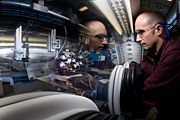- Number 306 |
- March 1, 2010
Smart windows: Energy efficiency with aview

NREL scientist Robert Tenant
manipulates an ink-jet sprayer
in a glove box. Tenant is
incorporating thin-film design
and manufacturing processes to
improve the performance and
lower the cost of dynamic
windows.
Researchers at DOE's National Renewable Energy Laboratory are trying to do the high-tech equivalent of putting sunglasses on buildings with a new generation of insulated "dynamic windows" that change color to modulate interior temperatures and lighting. Buildings consume 40 percent of the nearly 100 quadrillion Btus (quads) of energy the United States consumes annually. Conventional clear windows account for about one-tenth of the buildings' share of that energy load, or four quads. That's because they allow precious heat to leak out on chilly days or allow the incoming sun to warm a room to uncomfortable levels, and building's climate system struggles to adjust. Using dynamic windows to compensate for some of the electric lighting used inside buildings could save another quad of energy, according to NREL research scientist Dane Gillaspie. "Combined, a broad installation of these highly insulating, color-changing windows could save about one-eighth of all the energy used by buildings in the U.S. every year," Gillaspie said, "and about 5 percent of the nation's total energy budget."
[Joe Verrengia, 303.275.9831,
joe.verrengia@nrel.gov]
